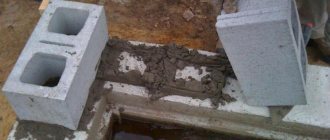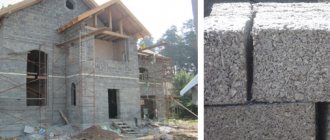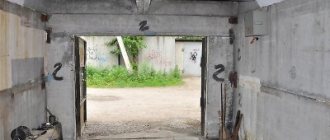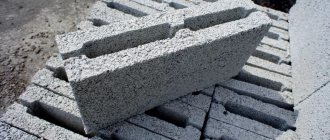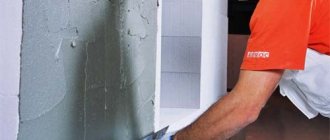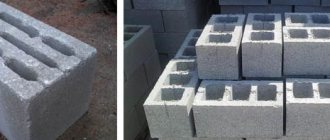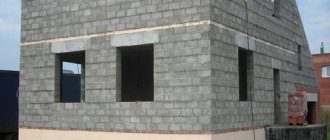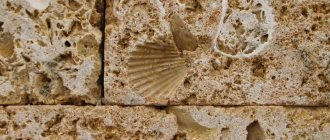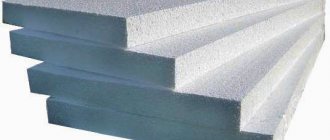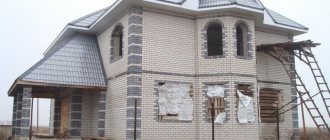Expanded clay blocks: basic concepts
Expanded clay blocks are made from a concrete mixture with the addition of fractional expanded clay. In particular, the composition of this material includes sand, cement, water and expanded clay.
The proportions of the ingredients depend on the density of the bricks you want to obtain and for what purposes they will be used.
Depending on the tasks, expanded clay blocks are classified into:
Thermal insulation blocks
Thermal insulation. In this category, concrete is prepared with a density of 350-600 kg/m3. The purpose of such blocks is thermal insulation of external walls of buildings.
Structural and thermal insulation blocks
Structural thermal insulation blocks have a density of 600-1400 kg/m3 and are used for thermal insulation and construction of internal floors in buildings.
Building blocks
Structural ones are characterized by a density of 1400-1800 kg/m3, and are used in the construction of load-bearing walls of buildings. The maximum number of floors is limited to 12 floors.
Why has the popularity of block construction increased?
For the construction of low-rise buildings, foam blocks, expanded clay blocks or gas blocks are increasingly being used. This can be explained by several advantages: Their sizes are slightly larger than regular bricks. To build a wall, you need less amount of fastening material. This simplifies the installation process;
- Correct geometry;
- Instead of regular mortar, you can use construction adhesive. Thin seams require low composition consumption and will not serve as cold bridges during operation;
- Porosity provides good thermal insulation. Finished walls made of one gas block or foam block do not need to be additionally insulated;
- The materials fully comply with environmental standards and do not emit harmful substances at high humidity or increased temperature;
- The low density and weight of an individual expanded clay block or gas block allows the use of a strip foundation with shallow depth or a columnar version for the construction of a house;
- Construction takes place without the use of expensive and complex equipment, and even an amateur can do it. You can save a lot on labor costs;
The main problem common to aerated concrete blocks, expanded clay blocks, and foam blocks is the need for protection from environmental influences. Let's take a closer look at the positive and negative aspects of expanded clay blocks and foam blocks.
Advantages and disadvantages of expanded clay concrete blocks
Expanded clay blocks have pros and cons, like any other building material. Below are the main advantages and disadvantages of this popular building material.
Advantages of using expanded clay blocks
- Due to the fact that expanded clay concrete is produced exclusively from natural materials, it poses absolutely no threat to human health.
- Expanded clay concrete has the first radiation safety class, which means that it does not accumulate dangerous radiation and does not emit it.
- The material fully meets the requirements of sanitary and hygienic standards in terms of sound insulation and vapor permeability values.
- Thanks to its high thermal conductivity and hollowness, the building is able to effectively store heat in winter and coolness in summer.
- Due to the fact that the material is quite light in weight, there is no need to build a complex, expensive foundation. In addition, transportation of the material will cost much less than analogues of this material.
- Due to the low weight of the blocks, less labor is required to erect wall structures.
- A building made of expanded clay concrete has minimal shrinkage values, which means cosmetic repairs will be required quite rarely.
Disadvantages when using expanded clay blocks
- The strength of heavy concrete is much higher than the strength of expanded clay concrete.
- Expanded clay blocks are not suitable for building foundations.
- The surfaces of the blocks do not always have a perfectly flat surface, which means that during installation, adjustment and trimming of the blocks will be required.
Characteristics of construction raw materials.
Often, wanting to retain heat inside the building, owners decide to carry out total thermal insulation of the house: install thick windows, reduce the number of ventilation hatches, and insulate the walls. The walls stop “breathing” due to increased density, which provokes the formation of mold, mildew and other troubles. Therefore, before making such a drastic decision, you should familiarize yourself with the pros and cons of a house made of expanded clay concrete blocks.
Expanded clay concrete wall slabs are characterized by high elasticity and strength, so when laying the foundation there is no great need to install reinforced belts. Expanded clay concrete is a material that has a unique set of the following characteristics:
- moisture resistance; lightness; reliability; resistance to temperature changes, corrosion, rotting, burning.
The primary material for making slabs is baked clay (expanded clay), which is foamed during the production process. The average density of the slabs is 400-1800 kilograms per cubic meter. The use of such blocks allows you to evaluate houses made of expanded clay concrete blocks based on the pros and cons, reduce energy costs, save time and money on the construction of a building of any functional purpose.
The use of composite material became popular in Russia more than 60 years ago.
The construction technology is quite simple and does not require special design solutions. The dimensions of the blocks make them easy and comfortable to transport, store and use in construction. The laying of expanded clay wall blocks is no different from ordinary brickwork.
Comparison of expanded clay blocks with alternative materials
When choosing a building material for building walls, you usually have to make a choice among the following building materials: expanded clay blocks, gas silicate blocks, foam concrete blocks and cinder blocks.
Below is a comparative description of each of them according to a number of parameters. Thanks to this comparison, it is easier to understand what expanded clay blocks have pros and cons compared to similar building materials.
| Properties | Expanded clay blocks | Gas silicate blocks | Foam blocks | Cinder blocks |
| Water permeability | Moderately hygroscopic | Highly hygroscopic | Hygroscopic | Weakly hygroscopic |
| Environmental friendliness | No toxic properties | May be toxic after fungal infection | Non-toxic when using natural foaming agents | Possible release of toxic substances, possible increased radioactive background |
| Compressive strength | Average | Low | Low | High |
| Price | Average price range | Low price range | Low price range | Average price range |
| Deviations in sizes | Medium, compensated by increasing the mortar during laying | Can be very significant | Medium, compensated by increasing the amount of solution | Low, compensated for by the increase in mortar during laying |
As you can see from the table presented, expanded clay blocks are inferior to other building materials in the following parameters:
- They are a relatively hygroscopic material (cinder blocks are almost not hygroscopic at all), prone to absorbing moisture. However, when the product dries, the structure does not break.
- They have average compressive strength, inferior to cinder block.
- They lose in cost to foam concrete and gas silicate blocks.
- They are slightly inferior to cinder blocks in terms of size deviation.
- Outperforms all competitors in terms of safety for human health.
See more on this topic on our website:
- Expanded clay blocks - dimensions, characteristics, use as a wall material Expanded clay block is a building stone that is produced by semi-dry vibrocompression. Expanded clay blocks have different sizes, but in shape they look like a large brick with air holes inside....
- We use foam concrete blocks - pros and cons in private construction So, you have decided that you will build your new house from modern materials. Foam concrete blocks have pros and cons just like other materials...
- Gas silicate wall blocks - the pros and cons of the material Laying load-bearing and self-supporting walls from gas silicate blocks during the construction of buildings is an economical and progressive method that is quite popular. Gas silicate blocks, pros and cons...
- Foam blocks - the pros and cons of the material for building a private house The construction of houses from foam concrete blocks is very popular all over the world. This popularity is explained by a number of advantages when working with this material: high speed of wall construction, low...
- Houses made of Finnish laminated timber - the pros and cons of the material When producing timber for building houses, only the most modern technologies are used. It is cut from solid trees to form a rectangular beam. This material is usually...
Building a house from expanded clay concrete blocks: pros and cons.
Composite clay wall panels are used in the construction of industrial and residential buildings. Expanded clay is a porous material that comes in the form of balls or granules. The composition of expanded clay concrete includes water, sand, cement and foamed clay. Thanks to their special structure, wall blocks are strong, but lighter than brick. The advantages of using expanded clay in construction are obvious: compared to conventional concrete, the material is a much more promising construction raw material.
Expanded clay concrete has high thermal conductivity and strength; despite minor disadvantages, houses made of expanded clay concrete blocks can boast of advantages. The most important advantage is the vapor permeability of the walls. This means that there is no need to install a vapor barrier; wall blocks are easy to manufacture and can be produced at home, which reduces the cost of building materials; the blocks have soundproofing properties; the material can be used for the construction of load-bearing structures; buildings built from expanded clay are not subject to shrinkage and are not deformed. The blocks are suitable for the construction of multi-storey buildings. Along with the advantages of houses made of expanded clay concrete blocks, this raw material also has disadvantages.
So, the main disadvantages of such buildings are the following: during masonry, “cold bridges” are always formed, so thin walls can be erected from expanded clay, which should then be insulated; the material is poorly ventilated; the technology for thermal insulation of a structure made of expanded clay concrete involves insulating the building from the outside . It is recommended to use mineral wool as an insulating material; the blocks have low frost resistance due to the porous structure of the material; products made from expanded clay concrete are highly fragile, so the material can only be used in certain areas of construction. Based on the pros and cons of a house made of expanded clay concrete blocks, what can be draw conclusions? Undoubtedly, the widespread use of the material in Europe and Russia allows us to be convinced that expanded clay concrete is the future. It is an environmentally friendly and affordable material that has many positive characteristics. The physicochemical properties of the composite are not inferior to stone.
Expanded clay concrete is used by many builders, but when constructing buildings, you should remember some of the above-listed features of the slabs. The relevance of using composite material in construction is due to the reduction of costs associated with the construction of a building and its operation. In addition, despite the disadvantages, country houses made of expanded clay concrete blocks have enough advantages. It is worth noting the low weight of the structure, reliability, thermal and sound insulation, moisture resistance and vapor permeability.
Wall blocks are so easy to use that you can even build a building with your own hands, without the use of special lifting equipment. Thus, you can independently organize the work and control the construction process.
High speed and ease of laying will help save time on construction. As you can see, despite the disadvantages of a house made of expanded clay concrete blocks, it has many more advantages, even in the photo. It is worth noting that the construction of partitions and walls from expanded clay concrete wall blocks does not require special engineering solutions. The material combines perfectly with reinforced concrete and metal structures, which simplifies the technology of laying the foundation of a building.
Expanded clay concrete allows you to maintain normal humidity in the room, creating the most comfortable microclimate, which is an important factor for comfortable living. The pros and cons of a house made of expanded clay concrete blocks are appreciated by many homeowners, builders and time-tested. The specific geometry of wall slabs allows you to save on finishing materials. Therefore, today projects for the construction of residential buildings from expanded clay concrete blocks are gaining wide popularity.
In the construction of houses and commercial buildings, concrete blocks are often used, which have many advantages over other materials. This is due to good thermal insulation, low specific gravity, and affordable cost. But what is the difference between expanded clay blocks and do they have any advantages?
